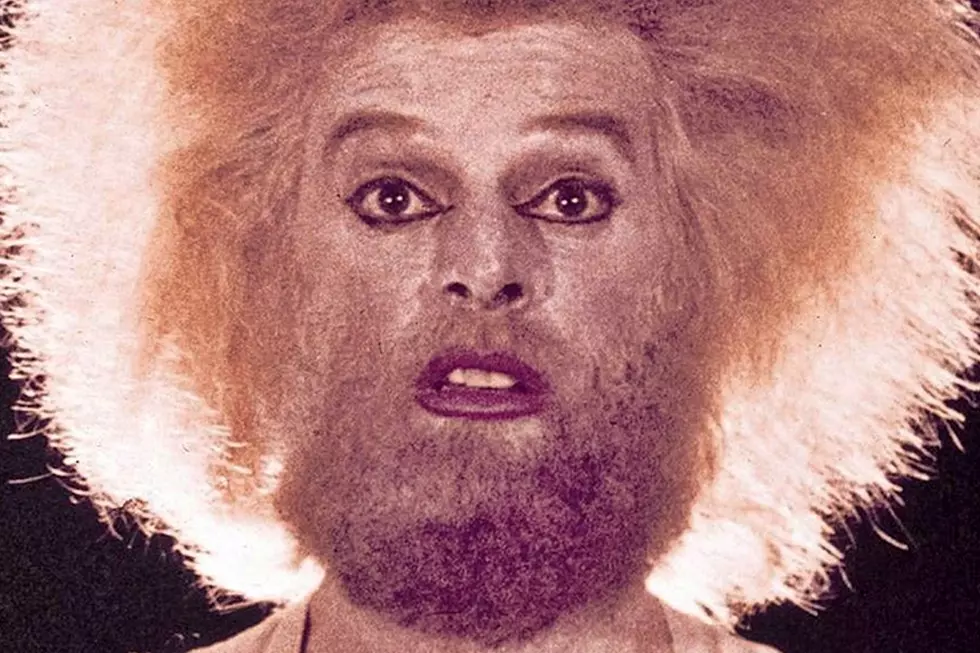
Jean ‘Moebius’ Giraud: Your Favorite Artist’s Favorite Artist

Recently, Marvel Comics Senior Vice President of Publishing Tom Brevoort honored Jean "Moebius" Giraud via Twitter meme. Prior to that, the LA Times Hero Complex blog featured the comics creator in an exclusive interview. Moebius is one of the most well-regarded talents in the entire comics industry -- and by that I mean Europe, the US, and Japan. Katsuhiro Otomo, creator of Akira, and Moebius were fans of each other, and Moebius even contributed a pinup to the classic manga series.
It's fair to say that Moebius has had an incredible influence on how comics and sci-fi look these days, and that he's probably your favorite artist's favorite artist. He even contributed to the Marvel Universe with our primary topic today, Silver Surfer: Parable.There are a lot of things worth examining in Moebius's work. You could look at the differences between his work under the pseudonym Moebius (generally sci-fi/fantasy) and Jean Giraud (more realistic). You could look at his incredible work as Giraud in his Blueberry series, the Western comic to beat all Western comics, or Moebius's Arzach, a silent and beautiful comic. Or you could even just visit The Airtight Garage, an imagedump Tumblr named after one of Moebius's best works and a great introduction to the man's art. Oh, hey, do you like movies? Alien, Blade Runner, and The Fifth Element, did you like those? Moebius had a hand in those, too.
Tons of ink has been spilled in praise of Moebius, but two of my favorite articles are Matt Seneca's "Your Monday Panel 15," covering page 1 panel 1 of Moebius's Le Garage Hermetique de Jerry Cornelius episode 26, and Sean Witzke's "Emma Peel Sessions 50 – Because it's everything, though everything was never the deal," covering the English translation of The Airtight Garage. These two get at exactly what makes Moebius so unbelievably talented. The two of them also joined forces to talk about my subject today, Silver Surfer: Parable in a two-part tag-team: here and here.

Why Silver Surfer: Parable? I have a few reasons. First, it's actually pretty easy to find if you live near a decent-sized comic shop or go to comic conventions. The collection lurks in dirty half-price trade booths, and the single issues aren't too expensive. Second, this book was a team-up between Moebius and Stan "The Man" Lee in 1988, long after Lee had essentially retired from regularly scripting comic books.
The biggest reason to pay attention to Silver Surfer: Parable is the dialogue it creates between Moebius and Jack Kirby. Kirby co-created the Surfer with Stan Lee, and we owe the language of cape comics to him. He brought a dynamism and blistering level of creativity to the comics page that was unmatched, and inspired generations of illustrators. Some of the best craftsmen in the field -- Jim Steranko, Frank Miller, and others -- borrowed or learned from Kirby's work and introduced their own spin on it.
Moebius is not without his own influence, of course. Travis Charest went from being an okay-at-best Jim Lee clone into a creator with a strong Moebius influence. Frank Quitely and Ladronn (who is also a child of Kirby) are two more immensely talented creators whose styles have been influenced by Moebius.
So, in the end, you have a book that's a perfect storm of comics legends. Stan & Jack helped revolutionize American comics. Moebius is a pioneer who has been at the top of his game. Kirby didn't have any direct involvement in this project, but when you collaborate with Lee on a project starring two of their greatest creations, you don't get to just ignore Kirby. He haunts the book, forcing you to compare his Surfer and visual storytelling to Moebius's. This is a master coming to play in another master's backyard, and at least a tip of the hat must be paid to the originator.

In his introduction, Kirby's Silver Surfer was muscular, but not brawny, in that Kirby way. He was on par with Black Panther or Captain America. His movements were exaggerated and played up for entertainment purposes, whether it was a panel of him leaning hard into a turn or hunching down to fire off energy bolts with all his strength. Kirby's Surfer over-acted and over-emoted. Every strike was a struggle, and every emotional beat the end of the world.
Moebius took a different tack. Where Kirby's take is all offense, Moebius created a Surfer that begins in a protective stance, covered in rags and his board tightly wrapped. He's hiding his light, literally and figuratively, and when it comes time for the big reveal, the biggest flourish you get is a hat flipped into the air right before a page turn. The fully revealed Silver Surfer is left holding his rags, his surfboard still wrapped and sitting on the ground. It's awkward and subdued, isn't it? Kirby's Surfer is explosive and majestic, a god in human form. Moebius's Surfer is quiet, a human in a god's form.

Moebius has already given you a lot to go on a purely visual basis, without even touching Lee's script (which is interesting in and of itself, but that is fodder for another post). The way Moebius draws the Surfer sets Moebius up as Kirby's opposite (and equal?) number. If Kirby is one half of the equation, Moebius is the other half.
Reading Parable with this in mind makes the book very interesting, and forces you to dig deep into Moebius's art. Where Kirby's Surfer wrenched his way through poses, Moebius's chose a more static approach. The Surfer stands tall throughout the book, rarely bending his knees more than a little. There's no real sense of speed to Moebius's action scenes, just a thin wisp of a speed line. The absence of speed actually makes it seem like Surfer simply appears in position, rather than moving. He slides through time and space, rather than travelling.

When the Surfer battles Galactus, Moebius plays up the difference in size between the two. The Surfer fits in the palm of Galactus's hand, which has the added effect of turning the twin speed lines into the equivalent of a housefly's trail. The Surfer is a pest, nothing more.

When Kirby's Surfer shoots energy bolts, he does it wildly. The bolts go in two different directions, his arms are held close in to his body, and he braces himself on his board. An equivalent scene in Parable, and one of the few examples of overt violence from Surfer in the story, is calmer. Surfer's knees are bent, but his posture is one of exertion, rather than extreme effort.

The secret is that Moebius's Surfer has a deep core of sadness down inside him. There's a certain level of resignation in his posture, whether he's wearing his rags or surfing through the air. His face tends toward blank or pained (he smiles but once in the entire book, I believe), an improvement over Kirby's stoically determined Surfer. You can see the weight of the Power Cosmic in Moebius's Surfer, and how the passage of time has effected him.
This is Moebius. You can zero in on just one aspect of his work ("How does he draw the Silver Surfer?") and find something worth chewing on. There are dozens of other things I could have talked about--his backgrounds, lettering, color palette, layouts, scale, crowds, and how he renders destruction--and there would have been just as much information to digest. Every panel is perfectly thought out and a story unto itself. Moebius's comics, even when silent, are dense.
It's easy to see why other artists look to Moebius for inspiration. He was far, far ahead of the curve, and some people are just now catching up to his innovations. Humanoids, the American arm of noted French publisher Les Humanoïdes Associés, released limited editions of Madwoman of the Sacred Heart and The Incal, two of his collaborations with Alejandro Jodorowsky (another comics legend). They quickly sold out, and while a new, softcover version of The Incal is due next month, you're most likely going to be doing some digging through second-hand bins to find books by Moebius.
It's absolutely worth it, though, and hopefully some kind-hearted publisher will do us the favor of releasing his work digitally or in the form of affordable paperbacks.

More From ComicsAlliance


![Brilliant Art, Tremendous Stories and Daring Creators: The 2016 Eisner Award Winners [SDCC 2016]](http://townsquare.media/site/622/files/2016/07/eisner2016.jpg?w=980&q=75)




![Slott And The Allreds Plot A Return to Earth in ‘Silver Surfer’ #1 [Preview]](http://townsquare.media/site/622/files/2015/12/silversurfer1.png?w=980&q=75)

